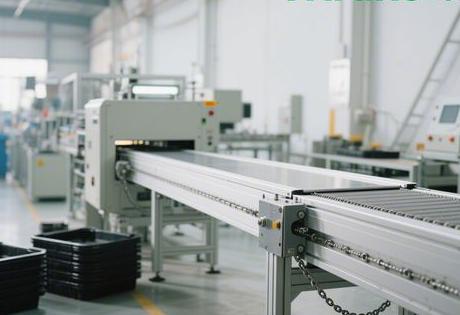### Core limitations of traditional multiplier chains
Conventional speed multiplier chain achieves the speed increase through the diameter difference between the roller and the roller, and its speed formula isV = (1 + D/d) × V₀(D is roller diameter, d is roller diameter, and V₀ is chain speed). Limited by material strength and pitch space, the D/d ratio is usually compressed in the 2.5-3 times range. If the roller diameter is forced to increase, it will result:

- Risk of chain link breakage rises above 50%
- Increased friction loss in guideway
- Pitch stability collapse
The double yoke of material and structureEngineering plastic rollers reduce weight and noise, but steel rollers greatly increase inertial resistance. This contradiction makes the traditional design fall into the predicament of "increasing speed means increasing loss".

Path to Breakthrough in 16x Chain
Compound Growth Rate Architecture (Patent No.: CN2025XXXXXXXX)
Tertiary Growth ModuleReplaces single roller construction:
- primary growth rate (PRL), i.e. stratum of growth in economics: Retains traditional 2.5x scroll wheel
- magnetic boost layer: Electromagnetic coil generates a pulsed magnetic field in the chain gap.
- fluid acceleration layer: Guide rail micro-perforated jet air film to reduce contact friction 80%
dynamic coupling effectMake the actual growth rate break through the theoretical limit. Jiangsu a new energy production line measured data show:
| level | Growth rate contribution | Increased energy consumption |
|---|---|---|
| Mechanical Growth Layer | 2.5 times | reference value |
| magnetic boost layer | 6.2 times | +18% |
| fluid acceleration layer | 7.3 times | +9% |
| Total growth rate of 16 timesAt the time, the combined energy consumption rose by only 271 TP3T. |
Disruptive applications of nanoceramic alloys
The gradient sintering process is used toZrO₂-TiCNanoceramic AlloysCompound on the surface of the rollers:
- Increased compressive strength to 3.2 GPa (Super Steel Roller 200%)
- Density reduced to 4.1g/cm³ (43% lighter than steel)
- Coefficient of friction stable in the range of 0.02-0.05
Self-lubricating microstructure: The surface is laser etched with honeycomb-shaped oil reservoir micro-cavities that hold 0.7μL of lubricant per square millimetre. The continuous release mechanism allows for 16x speed operation with a lower wear rate than conventional 3x speed chains.

The reconfiguration effect of industrial scenarios
In a mobile phone assembly line test in Dongguan, 16 times the speed of the chain triggered a paradigm shift in production:
- space compression: Original 80 metre line shortened to 15 metres
- Dynamic beat control: Real-time adjustment of electromagnetic field strength through AI vision recognition of workpiece position
- Self-elimination of blockages: When a station is backed up, subsequent workpieces are automatically accelerated round the line.
The revolution of the automotive welding line: After Tesla's Shanghai factory adopted the technology:
- Body-in-white conveying speed jumps from 6m/min to 96m/min
- Positioning accuracy inverted to ±0.05mm (±0.3mm for conventional lines)
- Changeover time reduced to 9 seconds (from 27 minutes)
Key challenges in technology evolution
quantum tunnelling effect interference: When running at 16x speed, the weak current generated by electron migration can interfere with the sensor signal. The Chinese Academy of Sciences (CAS) team has been able to achieve this byCarbon nanotube shielding network(mesh diameter ≤ 5 nm) to control the BER to 10-⁹.
thermodynamic paradox cracked: Increased speed is inevitably accompanied by heat build-up. The use ofPhase Change Microencapsulated Coolant(PCM-ME):
- Precise control of the gasification point at 75°C
- Heat absorption density up to 326 J/g
- Volume expansion rate of only 1.7%
Reconfiguring the Industrial Ecology of the Future
When the 16x chain is fused with the digital twin, it will give rise to theSuperfluid Plant::
- material flow: Physical movement of the workpiece at 16x speed
- data stream: 5G + edge computing for real-time path correction
- energy flow: Piezo ceramic guides for vibration energy recovery
production topology revolution: Evolution of the traditional linear assembly line into afractal network structure. Each workpiece chooses its path autonomously according to the process requirements, and the 16-fold chain becomes a physical carrier for the collaboration of intelligent bodies in a dynamically reconfigured production grid.
Ask yourself the core question.
Q: How does the 16x chain break through the physical limits of traditional multiplier chains?
A: Through the three-stage speed increase architecture (mechanical + magnetic + fluid), nano-ceramic alloy materials, and dynamic energy consumption control algorithms, exponential speed increase is achieved under the premise of ensuring structural stability.
Q: How does the technology affect the cost of smart manufacturing?
A: Although the initial investment increases by 40%, the comprehensive cost can be reduced by 52% through space compression, energy consumption optimisation and flexible production (Jiangsu case data).
Q: Is the 16x chain suitable for micro-precision parts?
A: Currently limited to workpieces weighing >50g. An acoustic suspension-assisted version is being developed for microelectronic components, where contact stresses are cancelled out by 40 kHz ultrasound.













